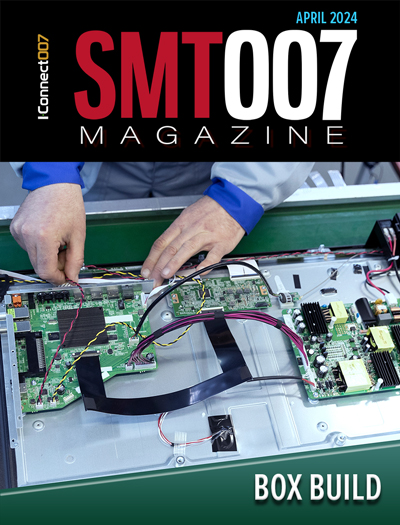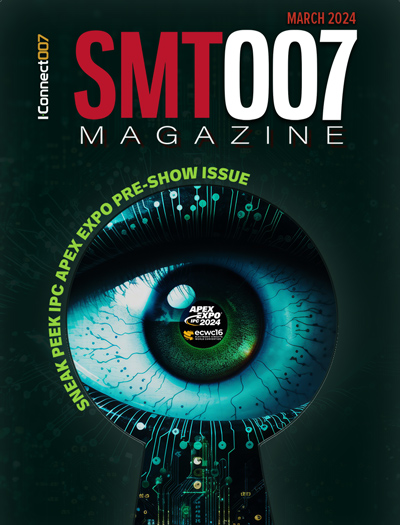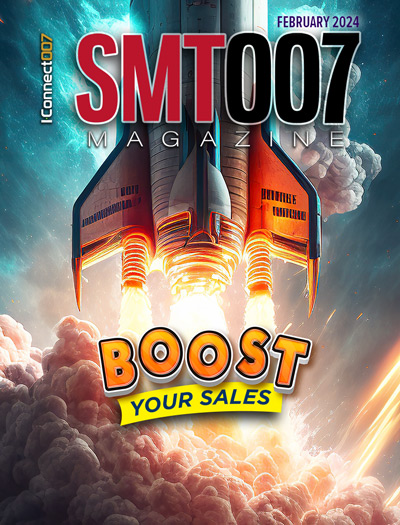-

- News
- Books
Featured Books
- smt007 Magazine
Latest Issues
Current Issue
Box Build
One trend is to add box build and final assembly to your product offering. In this issue, we explore the opportunities and risks of adding system assembly to your service portfolio.

IPC APEX EXPO 2024 Pre-show
This month’s issue devotes its pages to a comprehensive preview of the IPC APEX EXPO 2024 event. Whether your role is technical or business, if you're new-to-the-industry or seasoned veteran, you'll find value throughout this program.

Boost Your Sales
Every part of your business can be evaluated as a process, including your sales funnel. Optimizing your selling process requires a coordinated effort between marketing and sales. In this issue, industry experts in marketing and sales offer their best advice on how to boost your sales efforts.
- Articles
- Columns
Search Console
- Links
- Events
||| MENU - smt007 Magazine
Counseling Startups From Design Through NPI
April 30, 2020 | Andy Shaughnessy and Happy HoldenEstimated reading time: 2 minutes
Andy Shaughnessy and Happy Holden sat down for an interview with Richard Marshall, CEO of Xitex Limited, a company based in the U.K. that provides consultancy to startups launching wired and wirelessly connected products. Richard explains some of the most common factors companies overlook when introducing a new product. He also discusses one startup’s new product—a Fitbit-type device worn by horses—and why he advises startups to “Make your mistakes close to home.”
Andy Shaughnessy: How did you get involved in electronics?
Richard Marshall: As a kid, I grew up having various bits of electronics around. You don’t realize until later in life how much you learn from your own father. I grew up with that stuff, soldering and knowing resistor color codes, long before I studied physics.
Shaughnessy: As CEO, give us some background on Xitex.
Marshall: Xitex has been going for about 25 years. It’s my consulting company that I’ve been in and out of for a chunk of time. My last major startup was Ubiquisys, which was bought by Cisco in 2013. They were a small cell company, taking a 3G base station and miniaturizing it into a consumer product. We did one of the world’s first femtocells, which we started working on back in 2006. Then, it went for the usual acquisition phase with Cisco. I came out of Cisco in the backend of 2014, and since then, I’ve been running my design consultancy.
Partly, I’ve always enjoyed startups because you have to be able to turn your hand to do a lot of things. You have to get things done. As I often say to founders, execution is king. If you want to convince investors to fund you and back you, then execution is king. The moment you don’t start fulfilling your promises, then your business is likely to stop. There’s also a feeling of wanting to give something back in life, mentoring and helping other startups.
A couple of years ago, I was involved in a startup event in the U.K. and was talking to a couple of the founders, who were at Hive, which was bought by British Gas. One of the founders mentioned how hard it was to find people who had been through NPI in OEM manufacturing. And of course, for those of us who have worked for OEMs with our own production facilities, we tend to forget the fact that the world has changed so dramatically since 2000–2005, when so much manufacturing was first outsourced. Obviously, the majority of electronics have tended to be outsourced to Southeast Asia.
To read this entire article, which appeared in the April 2020 issue of Design007, click here.
Suggested Items
AIM Solder’s Dillon Zhu to Present on Ultraminiature Soldering at SMTA China East
04/22/2024 | AIMAIM Solder, a leading global manufacturer of solder assembly materials for the electronics industry, is pleased to announce that Dillon Zhu will present on the topic: Ultraminiature Soldering: Techniques, Technologies, and Standards at SMTA China East. This event is being held at the Shanghai World Expo Exhibition & Convention Center from April 24-25.
Hentec/RPS Publishes an Essential Guide to Selective Soldering Processing Tech Paper
04/17/2024 | Hentec Industries/RPS AutomationHentec Industries/RPS Automation, a leading manufacturer of selective soldering, lead tinning and solderability test equipment, announces that it has published a technical paper describing the critical process parameters that need to be optimized to ensure optimal results and guarantee the utmost in end-product quality.
New Book on Low-temperature Soldering Now Available
04/17/2024 | I-Connect007I-Connect007 is pleased to announce that The Printed Circuit Assembler’s Guide to… Low-temperature Soldering, Vol. 2, by subject matter experts at MacDermid Alpha Electronics Solutions, is now available for download.
Nordson Electronics Solutions Expands the SELECT Synchro Selective Soldering Equipment Family With New Synchro 3 Release
04/03/2024 | BUSINESS WIRENordson Electronics Solutions, a global leader in reliable electronics manufacturing technologies, releases the Synchro™ 3, a new model in the SELECT® Synchro™ selective soldering equipment family for high-volume printed circuit board assembly applications.
Revolutionizing Precision Soldering: Introducing the iBot-i1/2s by Sasinno Americas
04/02/2024 | Sasinno AmericasSasinno Americas is pleased to introduce its latest advancement in soldering technology – the iBot-i1/2s. This cutting-edge system redefines precision soldering with groundbreaking features designed to elevate efficiency and performance in electronics manufacturing processes.


